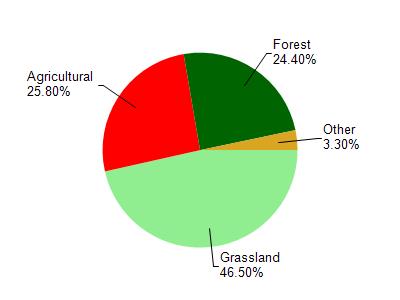Dane
Yes
No
No
Fish and Aquatic Life
Overview
Syftestad Creek is a tributary to Kittleson Valley Creek. It is a warm water forage fishery stream that may have trout potential (Day, 1985). Excess sedimentation has resulted in degraded habitat (DCRPC, 19926). Other problems resulting from polluted runoff are also may also exist. Redside dace, a fish on the state's threatened and endangered species list, has been found here.
Date
Author Aquatic Biologist
Overview
This stream is very similar to Pleasant Valley Branch in geographic location, hydrological characteristics, and problems. It is a potential cold water stream that currently only supports forage species due to excess sedimentation caused by runoff. It is on the state’s list of degraded (303d) waters. A rare fish species (redside dace) has been found in this stream. While much of the upper half of the stream remains in agriculture, the lower half is buffered by land which has been set aside or returned to prairie (Amrhein, pers. obs.) Fish and habitat monitoring conducted in 2002 showed the presence of mottled sculpin, a cold water indicator species; and a cold water index of biotic integrity of “fair”. However the stream lacks adequate cover to support high numbers of trout (Marshall, pers. comm). The DNR is planning a Redside Dace restoration project for the stream.
Date 2002
Author Aquatic Biologist
Historical Description
Syftestad Creek (Daleyville Branch) -T5N, R6E, Sec. 29, Surface acres = 1.8, Length = 5 miles, Stream order = I, Gradient = 28.2 ft/mile, Base discharge = 0.49 cfs.
Syftestad Creek is a spring-fed tributary to the Kittleson Valley Creek originating in Sections 9 and 17 of Perry Township (T5N, R6E). It drains 6 square miles of hilly pasture land in the driftless area and has good water quality despite bank erosion problems. Presently, Syftestad Creek supports only suckers and forage fish, but it has the potential to support a trout population if soil conservation measures are employed.
Fish species: central stoneroller, redside dace, brassy minnow, common shiner, southern redbelly dace, bluntnose and fathead minnow, creek chub, white sucker, brook stickleback, Johnny darter, and mottled sculpin.
From: Day, Elizabeth A.; Grzebieniak, Gayle P.; Osterby, Kurt M.; and Brynildson, Clifford L., 1985. Lake and Stream Classification Project. Surface Water Resources of Dane County, Wisconsin Department of Natural Resources, Madison, WI.
Date 1985
Author Surface Water Inventory Of Wisconsin
Recommendations
Restore Wetlands
Restore Wetlands
Standards Details
This water's entire reach downstream to the confluence with Kittleson Valley Creek.
Date 2010
Author Aquatic Biologist
Management Goals
Wisconsin's Water Quality Standards provide qualitative and quantitative goals for waters that are protective of Fishable, Swimmable conditions [Learn more]. Waters that do not meet water quality standards are considered impaired and restoration actions are planned and carried out until the water is once again fishable and swimmable
Management goals can include creation or implementation of a Total Maximum Daily Load analysis, a Nine Key Element Plan, or other restoration work, education and outreach and more. If specific recommendations exist for this water, they will be displayed below online.
Monitoring
Monitoring the condition of a river, stream, or lake includes gathering physical, chemical, biological, and habitat data. Comprehensive studies often gather all these parameters in great detail, while lighter assessment events will involve sampling physical, chemical and biological data such as macroinvertebrates. Aquatic macroinvertebrates and fish communities integrate watershed or catchment condition, providing great insight into overall ecosystem health. Chemical and habitat parameters tell researchers more about human induced problems including contaminated runoff, point source dischargers, or habitat issues that foster or limit the potential of aquatic communities to thrive in a given area. Wisconsin's Water Monitoring Strategy was recenty updated.
Grants and Management Projects
Monitoring Projects
| WBIC | Official Waterbody Name | Station ID | Station Name | Earliest Fieldwork Date | Latest Fieldwork Date | View Station | View Data |
|---|
| 908200 | Syftestad Creek | 10011914 | Syftestad Creek - Upstream Of Sth 78 At First Farm Rd. Crossing To Second Farm Rd. Crossing | | | Map | Data |
| 908200 | Syftestad Creek | 10058135 | Syftestad Creek - Confluence with Unnamed Trib (5038004) | | | Map | Data |
| 908200 | Syftestad Creek | 10011915 | Syftestad Creek - Syftestad Tributary Sth 78 To Farm Rd. Crossing | | | Map | Data |
| 908200 | Syftestad Creek | 10009789 | Syftestad Creek at County A Bridge | 6/11/1986 | 6/11/1986 | Map | Data |
| 908200 | Syftestad Creek | 10009362 | Syftestad Creek At Sth 78 | 6/5/1986 | 5/13/2015 | Map | Data |
| 908200 | Syftestad Creek | 10031453 | Syftestad Creek 100 ft E of Hwy 78 1.5 mi S of County A | 7/19/2010 | 1/1/2015 | Map | Data |
|

Watershed Characteristics
Syftestad Creek is located in the Gordon Creek watershed which is 76.90 mi². Land use in the watershed is primarily grassland (46.50%), agricultural (25.80%) and a mix of forest (24.40%) and other uses (3.30%). This watershed has 205.79 stream miles, 7.11 lake acres and 487.25 wetland acres.
Nonpoint Source Characteristics
This watershed is ranked High for runoff impacts on streams, Not Ranked for runoff impacts on lakes and High for runoff impacts on groundwater and therefore has an overall rank of High. This value can be used in ranking the watershed or individual waterbodies for grant funding under state and county programs.However, all waters are affected by diffuse pollutant sources regardless of initial water quality. Applications for specific runoff projects under state or county grant programs may be pursued. For more information, go to surface water program grants.